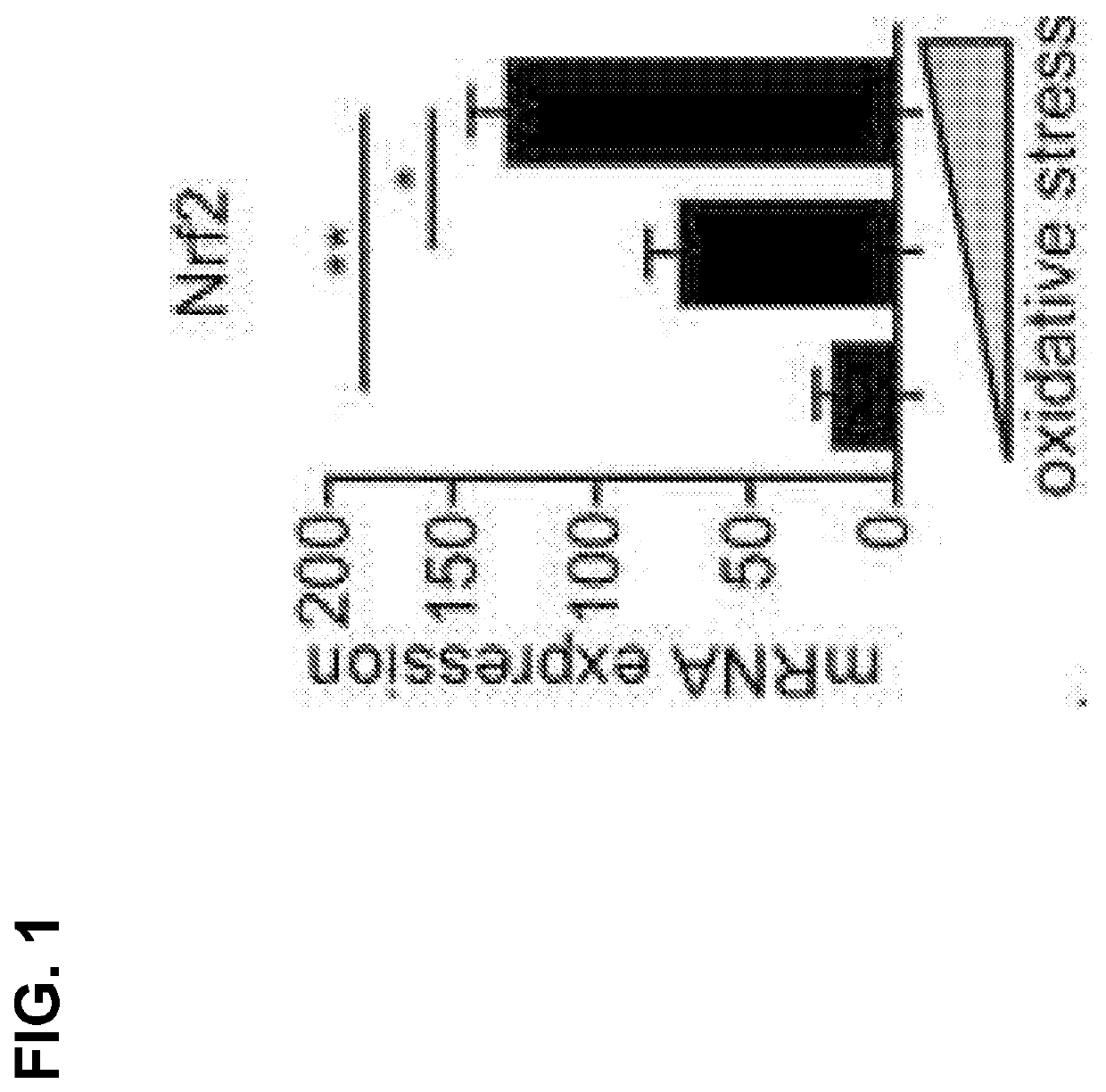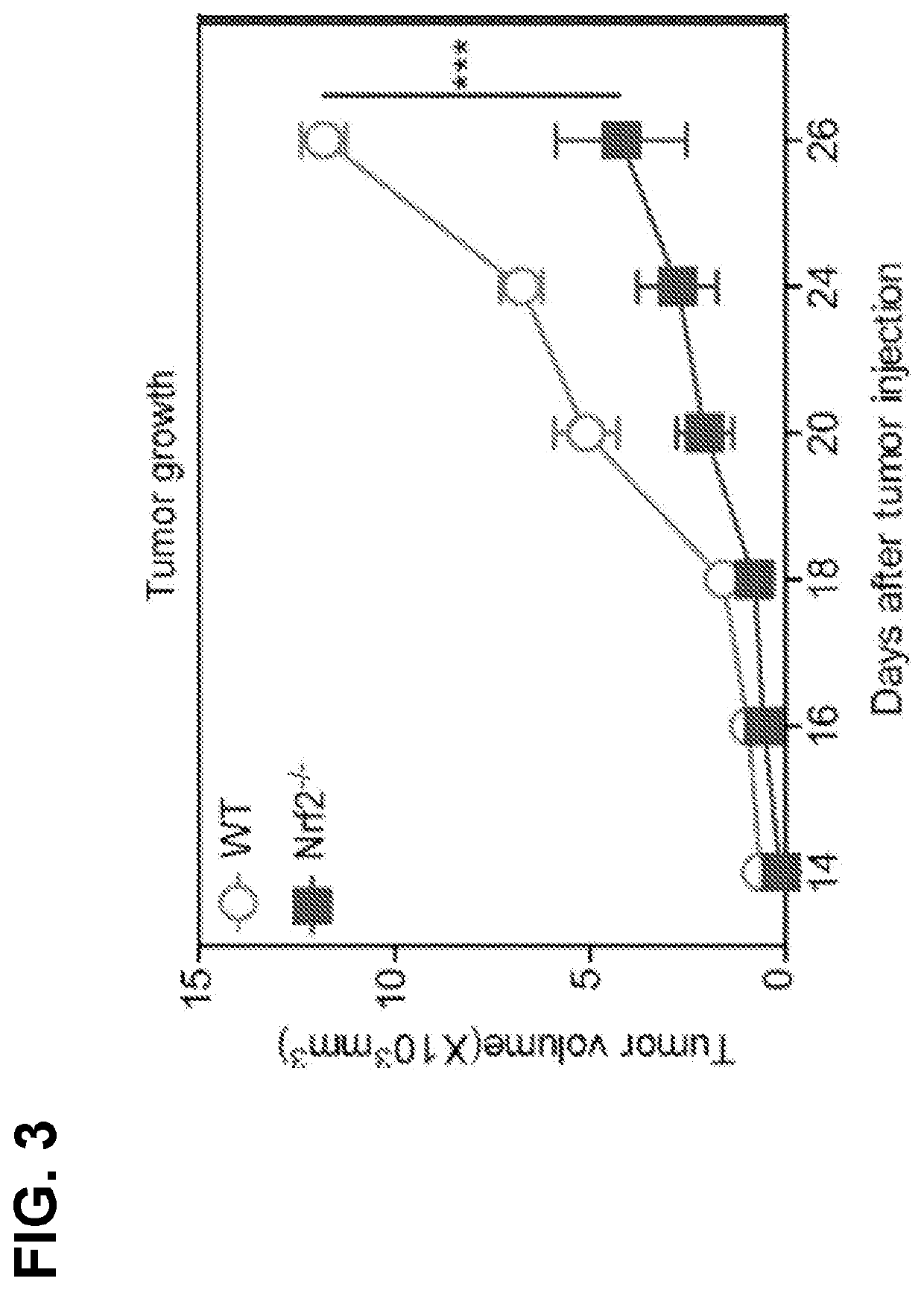Nrf-2 deficient cells and uses thereof
- Summary
- Abstract
- Description
- Claims
- Application Information
AI Technical Summary
Benefits of technology
Problems solved by technology
Method used
Image
Examples
example 1
tion of the Nrf2 mRNA Expression Level in Tumor-Infiltrating T Cells
[0200]The level of nuclear factor E2 factor related-factor 2 (Nrf2) mRNA expression in tumor-infiltrating T cells was determined. Nrf2 plays an important role in protecting cells from oxidative stress-mediated damage. To better understand the relationship between Nrf2 and oxidative stress, T cells were treated with varying concentrations of hydrogen peroxide, a known inducer of oxidative stress. As shown in FIG. 1, with increase in oxidative stress (i.e., higher concentration of H2O2), T cells expressed higher levels of Nrf2 mRNA. [0018] Nearly all cancers are associated with elevated oxidative stress. To better understand this phenomenon, T cells from tumors and / or different lymph nodes were isolated from tumor bearing mice. As a control, T cells from the lymph nodes of healthy mice were also isolated. As shown in FIG. 2, the level of Nrf2 mRNA expression in tumor-infiltrating T cells was very high compared with th...
example 2
tion of Anticancer Reaction that Changed with Modulation of Nrf2 Expression
[0201]To begin understanding how modulating Nrf2 expression can affect anti-tumor immune response, an Nrf2-deleted mouse was prepared for in vivo determination of T cell-mediated anticancer reaction that changed with modulation of Nrf2 expression.
2-1. Determination of the Ability to Inhibit Cancer Cell Proliferation
[0202]In order to determine the ability to inhibit cancer cell proliferation along with changes in modulation of Nrf2 expression, cancer cells were injected into the Nrf2-deleted mouse and a wild-type mouse, and then tumor volumes were measured. Specifically, melanoma (B16) cells were injected into the Nrf2-deleted mouse and the wild-type mouse; then, the proliferation of the cancer cells was observed by measuring tumor volume at various time points post tumor inoculation. The results are shown in FIGS. 3 and 4.
[0203]As shown in FIGS. 3 and 4, after injection of the melanoma cells, a significant ef...
example 3
tion of T Cell-Mediated Anticancer Reaction that Changed with Modulation of Nrf2 Expression
3-1. Determination of T Cell-Mediated Anticancer Reaction
[0209]The Nrf2-deleted mouse would give strong anticancer reactions to various cancer cells, which was confirmed in the above-described example 2. In order to determine whether the above-described phenomenon was a T cell-mediated anticancer reaction, treatment was performed such that the Nrf2-deleted mouse and the wild-type mouse went into a T cell-deficient state. Specifically, anti-CD3 antibody was administered to deplete the T cells. Some of the animals from both the tumor-bearing wild-type and Nrf2-deleted animals received the anti-CD3 antibody (control animals received an IgG control antibody); then, the cancer cell proliferation was observed by measuring both the tumor volume and tumor weight at various time points post tumor inoculation. The result is shown in FIGS. 8A and 8B.
[0210]As shown in FIGS. 8A and 8B, when the Nrf2-delete...
PUM
| Property | Measurement | Unit |
|---|---|---|
| Fraction | aaaaa | aaaaa |
| Fraction | aaaaa | aaaaa |
| Fraction | aaaaa | aaaaa |
Abstract
Description
Claims
Application Information
 Login to View More
Login to View More - R&D
- Intellectual Property
- Life Sciences
- Materials
- Tech Scout
- Unparalleled Data Quality
- Higher Quality Content
- 60% Fewer Hallucinations
Browse by: Latest US Patents, China's latest patents, Technical Efficacy Thesaurus, Application Domain, Technology Topic, Popular Technical Reports.
© 2025 PatSnap. All rights reserved.Legal|Privacy policy|Modern Slavery Act Transparency Statement|Sitemap|About US| Contact US: help@patsnap.com



